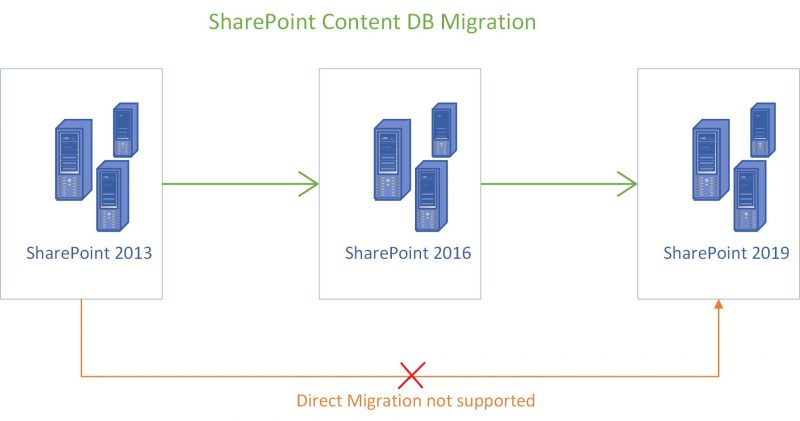Are you planning to migrate SharePoint content to a newer version and looking for details about migration options? This blog post is divided into two parts: part one covers SharePoint migration types, and part two will cover additional migration tools to help you with your SharePoint migration.
Content migration is the process of moving content from existing legacy solutions and systems to modern solutions. SharePoint is one of the most powerful content management platforms, evolving over time to meet modernization efficiencies in the content management world. SharePoint content migrations are required if your organization is planning to migrate content from earlier SharePoint versions to newer versions, or if you need to migrate content from other solutions to SharePoint. Migrating to SharePoint Online will let you take advantage of the collaboration and productivity tools that come with the latest version.
SharePoint Migration Types
Content Database Migration
A content database migration is the simplest way to migrate from an on-premises SharePoint version to another. Prior to the SharePoint Server 2013 and SharePoint 2016 versions, this was the most popular way to migrate to SharePoint. There weren’t many migration tools available and there was often a cost associated with those tools. Content database migrations, on the other hand, are free but can sometimes get complicated.
Complications occur when one version of SharePoint has multiple custom solutions and features that need to be enabled on the newer version. For the content database to support the most recent version, it’s important to note that when migrating to a newer SharePoint version, you must first migrate to the version(s) between your current version and the target version. For example, if you are migrating from SharePoint Server 2010 to SharePoint Server 2019, you need to migrate to SharePoint Server 2013 first, then to SharePoint Server 2016, and finally to SharePoint Server 2019.

Content database migration process:
A content database migration involves five steps. The following example shows a migration from SharePoint 2013 farm to a SharePoint 2016 farm. The same steps would be required for migrating SharePoint 2016 to SharePoint 2019.
- First, copy the existing content database from SharePoint 2013 farm
- Upload content database to the newer SharePoint 2016 farm.
- Upgrade the service applications in the SharePoint 2016 farm.
- After upgrading service applications, upgrade the content databases
- Finally upgrade the site collections.

The same steps are required to migrate from a SharePoint Server 2016 farm to a SharePoint 2019 farm. Note: these steps do not apply to SharePoint Online migrations.
Migrating SharePoint On-Premises to SharePoint Online
When migrating to Microsoft 365 and take advantage of cloud-based computing, organizations are migrating their legacy SharePoint on-premises versions to SharePoint Online. SharePoint Online is easily accessible from all devices and from anywhere.
As noted, you cannot use the content database to migrate from on premises versions of SharePoint to SharePoint Online. However, Microsoft provides SharePoint Migration Tool (SPMT), a free tool to help organizations migrate content from their existing on-premises systems to SharePoint Online (more details will be available in the second part of this blog about migration tools).
Migrating Third-Party Systems or File Shares to SharePoint Online
So far, I’ve covered content migration from one version of SharePoint to another. However, there are multiple ways, organizations manage and share content. These include server file shares, network drives, third-party solutions like Box, Dropbox, Google Workspace and many other content management tools.
Microsoft provides two free tools for these types of migrations. These are SharePoint Migration Manager and Mover.IO. There are also third-party tools that can help migrate content from different sources (Box, Dropbox, Google Drive, etc.) to SharePoint online.
Tenant-to-Tenant Migrations
Microsoft 365 tenant-to-tenant migrations are becoming quite common. They migrate Active Directory users and groups, Microsoft Teams, OneDrive storage, and SharePoint site content for SharePoint on-premises and SharePoint Online.
These migrations are also common among acquisitions of one organization to another, or mergers of two or more organizations. At Olive + Goose, we have successfully completed many tenant-to-tenant migrations. Until now, this migration type wasn’t possible out of the box or through a free tool. PowerShell can help but requires a lot of effort. Mover.IO is a free tool from Microsoft that helps migrate OneDrive content, but it cannot migrate users, mailboxes, and OneDrive storage. To migrate those types of content, you need a third-party tool like Cloudiway, MigrationWiz, AvePointe Online Services, etc. Moving a SharePoint document library is possible with a separate SharePoint migration tool like Sharegate.
Note: Mover’s migrations are now available in Migration Manager, which is now the recommended Microsoft tool. Mover.IO is being retired at end of December 2022. You’ll no longer be able to continue existing Mover admin migrations from Box admin, Dropbox admin, Google Drive admin, and Egnyte. Additionally, migrations between two Microsoft 365 tenants will no longer be supported by January 31, 2023. For more information, see Mover.io retirement timeline.
We can help
Our SharePoint experts have expertise on information architecture design, SharePoint farm design, migrations, workflow implementation, and custom development.
We at Olive + Goose would be happy to assist you with your SharePoint migration needs. Email [email protected] or your account executive for more information.
